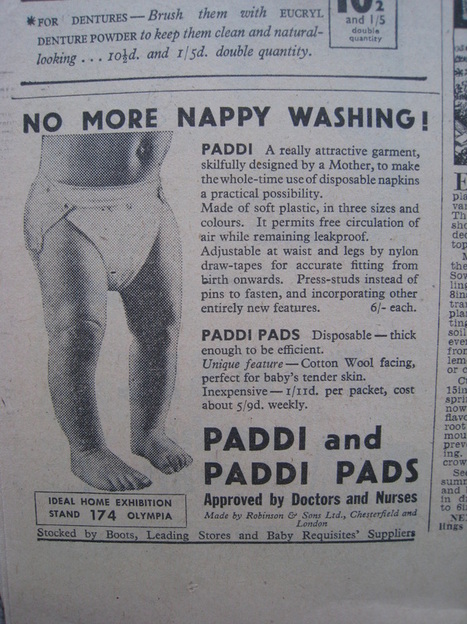The History of Paddi
(Nappies are called diapers in America)
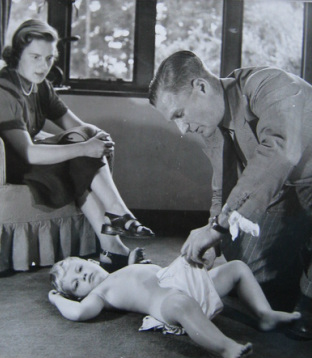 Valerie and her husband and son Nigel
Valerie and her husband and son Nigel
Valerie de Ferranti married Pat Hunter Gordon during the second world war. She was a war bride who was lucky. Her soldier fiance, did return alive from Dunkirk and so the wedding was able to go ahead.
By the time the war was finished and Britain was struggling to get back to normal, she was having her third child (1947) and was fed up washing nappies.
She was the sort of woman who always looked for a better way of doing something, especially if that something was laborious and boring.
Her grandfather SEBASTIAN de FERRANTI had been an inventor and perhaps she had inherited some of his genes
The problem was that plastic was in its infancy and was not available. Mothers sometimes used rubber pants over terry nappies / diapers to prevent leakage. Rubber pants were very much disapproved of by the medical profession. Doctors thought that the rubber would act as a poultice and do terrible things to the baby. At baby clinics, mothers could be seen surreptitiously taking off their baby's rubber pants before the doctor or nurse saw them.
Valerie Hunter Gordon decided that she needed a two part system - a pad and a garment to hold it.
Initially for the pad, she experimented using a pad made from a roll of cotton wool. This proved to be too difficult to cut and too expensive. She then found Cellosene rolls in the chemist (cellulose tissue wadding) which although cheap and absorbent, was not suitable, as it was very rough next to the baby's skin and crumbled into small bits when wet. She decided that the best option would be a combination of cellulose tissue wadding for absorbency, covered with soft cotton wool to protect the skin.
The garment she made was adjustable at the waist and at the leg openings so as to fit the baby perfectly. It was also waterproof. These two factors were essential to prevent leakage. The shape caused the pad to stay in position without safety pins. It was also soft and comfortable and suitable for a baby to wear. It was simple and easy to wipe clean and tough enough to withstand wear and washing and bleaching.It was quick and easy to put on or take off using press stud fastenings.
It is now quite remarkable to learn that she made the first Paddi garments out of old nylon parachutes. However she soon found some early rolls of plastic sheeting (PVC) which was just becoming available.
The first garment was such a success and so admired by all her friends that Mrs Hunter Gordon (while constantly modifying and adapting them) was persuaded to make garments for many friends - mainly other army mothers. She made more than 400 using her sewing machine at her kitchen table.
Her husband, Major Hunter Gordon (a Royal Engineer), now back from fighting abroad in Borneo, was pressed into helping when he had time. After a while he realised that perhaps there could be a commercial possibility. They approached several companies and were scorned by all. No company could see the potential - that it might be a product with general appeal.
However they pressed ahead and applied for a PATENT in April 1948
At last, a breakthrough came when Valerie Hunter Gordon's father met, quite by accident, at a business dinner, Sir Robert Robinson a Director of Robinsons of Chesterfield
On being asked what he did, Sir Robert said
By the time the war was finished and Britain was struggling to get back to normal, she was having her third child (1947) and was fed up washing nappies.
She was the sort of woman who always looked for a better way of doing something, especially if that something was laborious and boring.
Her grandfather SEBASTIAN de FERRANTI had been an inventor and perhaps she had inherited some of his genes
The problem was that plastic was in its infancy and was not available. Mothers sometimes used rubber pants over terry nappies / diapers to prevent leakage. Rubber pants were very much disapproved of by the medical profession. Doctors thought that the rubber would act as a poultice and do terrible things to the baby. At baby clinics, mothers could be seen surreptitiously taking off their baby's rubber pants before the doctor or nurse saw them.
Valerie Hunter Gordon decided that she needed a two part system - a pad and a garment to hold it.
Initially for the pad, she experimented using a pad made from a roll of cotton wool. This proved to be too difficult to cut and too expensive. She then found Cellosene rolls in the chemist (cellulose tissue wadding) which although cheap and absorbent, was not suitable, as it was very rough next to the baby's skin and crumbled into small bits when wet. She decided that the best option would be a combination of cellulose tissue wadding for absorbency, covered with soft cotton wool to protect the skin.
The garment she made was adjustable at the waist and at the leg openings so as to fit the baby perfectly. It was also waterproof. These two factors were essential to prevent leakage. The shape caused the pad to stay in position without safety pins. It was also soft and comfortable and suitable for a baby to wear. It was simple and easy to wipe clean and tough enough to withstand wear and washing and bleaching.It was quick and easy to put on or take off using press stud fastenings.
It is now quite remarkable to learn that she made the first Paddi garments out of old nylon parachutes. However she soon found some early rolls of plastic sheeting (PVC) which was just becoming available.
The first garment was such a success and so admired by all her friends that Mrs Hunter Gordon (while constantly modifying and adapting them) was persuaded to make garments for many friends - mainly other army mothers. She made more than 400 using her sewing machine at her kitchen table.
Her husband, Major Hunter Gordon (a Royal Engineer), now back from fighting abroad in Borneo, was pressed into helping when he had time. After a while he realised that perhaps there could be a commercial possibility. They approached several companies and were scorned by all. No company could see the potential - that it might be a product with general appeal.
However they pressed ahead and applied for a PATENT in April 1948
At last, a breakthrough came when Valerie Hunter Gordon's father met, quite by accident, at a business dinner, Sir Robert Robinson a Director of Robinsons of Chesterfield
On being asked what he did, Sir Robert said
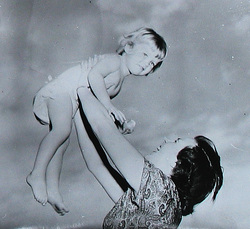
"I run a company in which we try to market sanitary towels at prices affordable to all women".
Her father replied
"Good heavens you must have a mind like my daughter "
and explained the situation.
Sir Robert asked him to tell Valerie to get in contact with his brother Victor Robinson, The Chairman of the company, and that was the start of a long and productive partnership.
An agreement was signed in 1949 for Robinsons to market the product.
see extracts from a book Robinsons of Chesterfield -
THE PADDI STORY
Her father replied
"Good heavens you must have a mind like my daughter "
and explained the situation.
Sir Robert asked him to tell Valerie to get in contact with his brother Victor Robinson, The Chairman of the company, and that was the start of a long and productive partnership.
An agreement was signed in 1949 for Robinsons to market the product.
see extracts from a book Robinsons of Chesterfield -
THE PADDI STORY
Robinsons had recently got access to the first plastic sheeting material for general commercial use and were able to put this at Valerie Hunter Gordon's disposal, to furthur develop the garment. They were also able to make up pads to her specification.
One thing that still had to be done was to find a name. Up to this stage it had not had one. Many names were suggested .
The list was long -
Valette, Snappy, Napkins, Lavnets, Drypad, Drytot, Easynap, Beautykin, Startwell, Paddi, Padinap, Padlet, Padikin, Quicky, Nappy Knicker, Lifesaver
Uniquely for such matters, the final decision was made at the end of a meeting between Major Hunter Gordon and a group of senior executive Army officers at The Army Staff College, Camberley, Surrey.
So Paddi came into existence with a little help from The British Army!
After that came advertising and marketing.
Doctors had to be convinced that Paddi was safe and that it would not act as a poultice and harm the baby's skin.
It was a positive article written to 'The Lancet' by an army doctor friend (whose wife had safely used Paddi on her baby) which helped change medical opinion.
The idea of easy disposability was also a bit of a barrier to start with, the extensive rationing of the war and the shortages of the inter war years led to a collective dislike to throwing anything away, it was felt to be extragavant.
A stand (no 104) was taken at The Mothercraft Exhibition Nov 4-14th 1950 at The Central Hall, Westminster, London
One thing that still had to be done was to find a name. Up to this stage it had not had one. Many names were suggested .
The list was long -
Valette, Snappy, Napkins, Lavnets, Drypad, Drytot, Easynap, Beautykin, Startwell, Paddi, Padinap, Padlet, Padikin, Quicky, Nappy Knicker, Lifesaver
Uniquely for such matters, the final decision was made at the end of a meeting between Major Hunter Gordon and a group of senior executive Army officers at The Army Staff College, Camberley, Surrey.
So Paddi came into existence with a little help from The British Army!
After that came advertising and marketing.
Doctors had to be convinced that Paddi was safe and that it would not act as a poultice and harm the baby's skin.
It was a positive article written to 'The Lancet' by an army doctor friend (whose wife had safely used Paddi on her baby) which helped change medical opinion.
The idea of easy disposability was also a bit of a barrier to start with, the extensive rationing of the war and the shortages of the inter war years led to a collective dislike to throwing anything away, it was felt to be extragavant.
A stand (no 104) was taken at The Mothercraft Exhibition Nov 4-14th 1950 at The Central Hall, Westminster, London
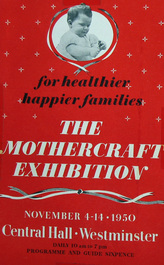
Things were greatly helped when Boots The Chemist then agreed to stock and distribute Paddi throughout all its branches in the UK
Later a stand (no 174) was taken at the 1952 Ideal Home Exhibition. This gave a tremendous boost to the sales and created widespread interest in Paddi
It was picked up by The BBC as one of the 6 most interesting products and subsequently featured in an evening television programme, which greatly increased interest.
Over time Paddi was constantly being improved by Valerie Hunter Gordon. ie Making several different sizes. Her own children being used as models.
Later a stand (no 174) was taken at the 1952 Ideal Home Exhibition. This gave a tremendous boost to the sales and created widespread interest in Paddi
It was picked up by The BBC as one of the 6 most interesting products and subsequently featured in an evening television programme, which greatly increased interest.
Over time Paddi was constantly being improved by Valerie Hunter Gordon. ie Making several different sizes. Her own children being used as models.
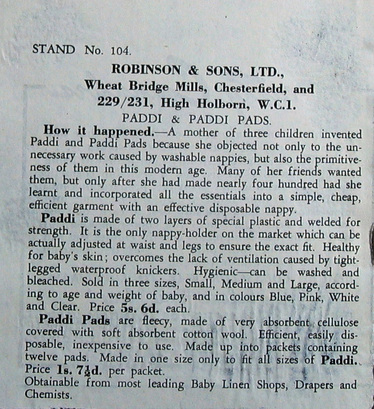
It became a huge commercial success for Robinsons and earned
Valerie Hunter Gordon some helpful royalties
Perhaps an unexpected outcome of Paddi (because it was no longer necessary to wash nappies) was that Pat and Valerie Hunter Gordon went on to have six children !

